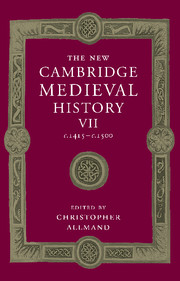Book contents
- Frontmatter
- PART I GOVERNMENT
- PART II ECONOMIC AND SOCIAL DEVELOPMENTS
- PART III SPIRITUAL, CULTURAL AND ARTISTIC LIFE
- PART IV THE DEVELOPMENT OF EUROPEAN STATES
- 17 Germany and the Empire
- 18 Hus, the Hussites and Bohemia
- 19 France
- 20 Burgundy
- 21 England
- 22 The Celtic world
- (a) Ireland
- (b) Scotland: 1406–1513
- (c) Wales
- 23 Italy
- 24 The Iberian peninsula
- 25 The Swiss Confederation
- 26 The States of Scandinavia, c. 1390– c. 1536
- 27 Hungary: Crown and Estates
- 28 The Kingdom of Poland and the Grand Duchy of Lithuania, 1370–1506
- 29 Russia
- 30 Byzantium: The Roman Orthodox World, 1393–1492
- 31 The Latin East
- 32 The Ottoman World
- 33 Conclusion
- Appendix Genealogical Tables
- Primary Sources and Secondary Works Arranged by Chapter
- Index
- Frontispiece
- Plate section
- Map 1 European towns in the late Middle Ages
- Map 2 European commerce and trade
- Map 4 Winds and currents facilitating the discoveries
- Map 5 The universities o f Europe in 1400 and 1500
- Map 6 Germany and the Empire
- Map 20 The Roman Orthodox and Ottoman worlds in the fifteenth century
- References
(a) - Ireland
from 22 - The Celtic world
Published online by Cambridge University Press: 28 March 2008
- Frontmatter
- PART I GOVERNMENT
- PART II ECONOMIC AND SOCIAL DEVELOPMENTS
- PART III SPIRITUAL, CULTURAL AND ARTISTIC LIFE
- PART IV THE DEVELOPMENT OF EUROPEAN STATES
- 17 Germany and the Empire
- 18 Hus, the Hussites and Bohemia
- 19 France
- 20 Burgundy
- 21 England
- 22 The Celtic world
- (a) Ireland
- (b) Scotland: 1406–1513
- (c) Wales
- 23 Italy
- 24 The Iberian peninsula
- 25 The Swiss Confederation
- 26 The States of Scandinavia, c. 1390– c. 1536
- 27 Hungary: Crown and Estates
- 28 The Kingdom of Poland and the Grand Duchy of Lithuania, 1370–1506
- 29 Russia
- 30 Byzantium: The Roman Orthodox World, 1393–1492
- 31 The Latin East
- 32 The Ottoman World
- 33 Conclusion
- Appendix Genealogical Tables
- Primary Sources and Secondary Works Arranged by Chapter
- Index
- Frontispiece
- Plate section
- Map 1 European towns in the late Middle Ages
- Map 2 European commerce and trade
- Map 4 Winds and currents facilitating the discoveries
- Map 5 The universities o f Europe in 1400 and 1500
- Map 6 Germany and the Empire
- Map 20 The Roman Orthodox and Ottoman worlds in the fifteenth century
- References
Summary
richard II was unusual, indeed unique, among medieval English monarchs in making two visits to Ireland in the course of his reign. Within Ireland, the results of royal intervention were disappointing. Before the end of 1399 the acting chief governor of Ireland reported to the English administration that the ‘Irish enemies’ were ‘strong and arrogant and of great power’, that they were aided in their assaults on the king’s loyal subjects by ‘English rebels’ with the result that ‘the law cannot be executed and no officer dares to attempt to execute it’; for there were no soldiers and no resources to pay soldiers to protect the king’s subjects against these attacks.
Ultimately, the king’s expeditions achieved little, but Richard II had at least attempted to go beyond the normal objective of military containment and to formulate proposals for a more lasting political settlement. He could not but be aware of the ethnic division within Ireland which, as we have seen, could lead the administration in Dublin to categorise even its foes on the basis of their real or supposed descent as ‘English rebels’ (opponents of English stock) or ‘Irish enemies’ (hostile Gaelic Irish).
Keywords
- Type
- Chapter
- Information
- The New Cambridge Medieval History , pp. 496 - 513Publisher: Cambridge University PressPrint publication year: 1998
References
- 25
- Cited by

